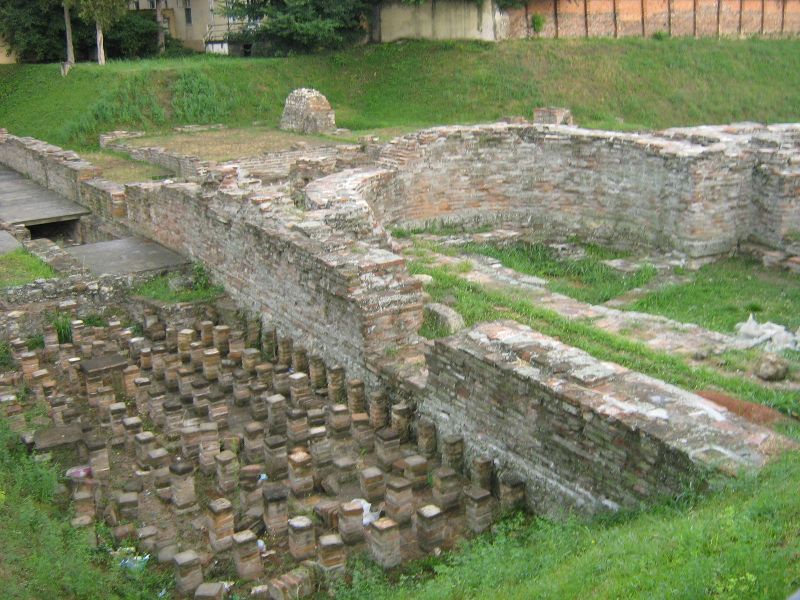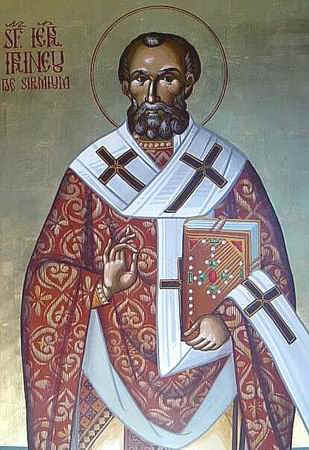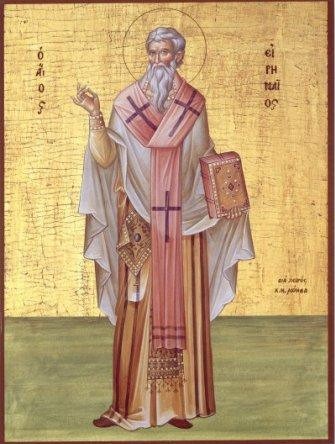Saint Irenaeus (or Irenaios) of
Sirmium, bishop of the most important roman city in the 3rd century on
the Danube, is a martyr saint of the latest roman persecutions against the
Christian in the Balkans.
As already mentioned
in the passio of Sts. Montanus and Maxima (+26 March 304), the situation of the
Christians in the western Balkans (province of Illyricum) at the end of the 3rd
century was quite difficult. The Roman Tetrarchy, composed by Diocletian, Galerius,
Maximian Hercules and Constantius Chlorus gave four edicts against the
Christians, three in 303 and one in 304. Because the new religion didn’t accept
the imperial cult, its adepts were considered direct enemies of the state and
therefore the ones discovered to be adepts of this dangerous faith were
tortured to death, in order to come back to “order”. Of course, the most hunted
were the members of the hierarchy as the leaders of the community.
The imperial edicts
stated, near the physical punishments, the destruction of the Christian places
of worship, the confiscation of the Christian possessions. Of course, the edict had a different way of
applicability in the roman provinces. Galerius, who governed the Illyricum from
its capital, Sirmium (today Mitrovitsa, not far away from Belgrade) since 21
May 295, respected strictly the decisions of the edicts. There is quite
possible to be influenced by his mother, Romula, who detested the Christians. In
this context was tortured and killed St. Irenaeus, the bishop from Sirmium.
There is unknown if he was the first bishop of this important city, or there
were some other bishops before.
The martyrical act of
St. Irenaeus is kept into Latin in its original form, being probably a copy
after the verbal process from the court leaded by the governor (praeses) of
Pannonia, Probus, the same who convicted a few days before the priest Montanus
and his wife, Maxima. Probably only the introduction and the conclusions of
this text were added by a Christian author. The document is important because
it attests the Christianity in the Danube provinces, but also by describing the
roman judging procedure in the times of Diocletian and Galerius. The critical
edition of this text was edited and published in Latin and English by Herbert
Musurillo in The Acts of the Christian
Martyrs, The Martyrdom of Saint Irenaeus Bishop of Sirmium, Oxford, 1972.
The resume of this
text it will be reproduced in the following: Saint Irenaeus, in spite of being
bishop, was married and had young children. He was arrested by the order of
Probus and judged in the court from Simium. Probus asked him to obey the law
and to sacrifice for the gods, by Irenaeus responded that “the one who sacrifice to gods and not to God will be removed from the
chosen ones” (Acta II,1).
Refusing to bring sacrifice, he was prepared for tortured, saying that he is
happy to be a part of the Lord’s sufferings. Probus still repeated his
question, whether sacrificing or not, during the torture. Later, trying to
convince him in another way, he brought the parents of the bishop and later his
children who asked him to have mercy of them. The other relatives tried to
convince him, telling “have mercy of your youth” . In any case he refused
repeatedly so Probus sent him finally into jail for some days.
Later, Probus ordered
that Irenaeus to be brought in the middle of the night and started the torture
again. After beating him with rods, the governor asked him if he has relatives,
children, wife, parents, but he answered “no” and stated that any Christian
loving his relatives more than God is not worthy of his Master (Mt. 10,37).
Probus tried once more to convince him for the sake of his children, bur
Irenaeus said that they have the same God who can save them. Finally Probus
didn’t resist anymore so he menaced him by beheading him. Irenaeus thanked for
that and asked the Roman governor to do it, in order to see how the Christians
learned to despise the death for their faith in God. Shortly after, the
soldiers have cut his head on the bridge of Basent in this city. In the last
moments he prayed to the Lord with these words: “Lord Jesus Christ, who kindly wanted to suffer the passions for the
salvation of the world, please open your heavens, in order that your angels
receive the soul of your servant Irenaeus, who is dying in your name and for
your people, who increases in your universal (catholic) church from Sirmium. I
am begging you and praying your mercy, receive me to you and kindly strengthen
the others into your faith”. After beheading, he was thrown in Sava, the
river flowing nearby.
The author of the text
ends the story by saying that he was martyrized in the 8th day of
the Ides of April (6th April) during the governing of Emperor
Diocletian and governor Probus, but also during the royal times of our Lord
Jesus Christ.
Saint Demetrius, deacon in Sirmium
A few days
later, on 9th April of the same year some martyrologies celebrate
the martyrdom of St. Demetrius, the deacon of bishop Irenaeus. He was killed
being pierced in the side with a spear. According to some hagiologists in the
Eastern Europe, the real identity of St. Martyr Demetrius of Thessalonica,
celebrated on 26 October, was not one of a soldier, but of a deacon. An
argument for this identification is that even later in the synaxarion composed
by Symeon Metaphrastes in the 10th century attests the fact that a
servant of the deacon, named Lupus, recovered his orarion reddened by the blood of the martyr and brought this holy
relic to his community (though here it is Thessalonica and not Sirmium). In
this context, it can’t be explained why a soldier would have an orarion, which
is a typical piece of clothe for a deacon. Moreover, in the first depictions,
St. Demetrius is represented as a member of the noble class and not as a
soldier.
St. Lupus,
his servant died also as a martyr, being celebrated on 23 August. It is
supposed that the cult of St. Demetrius spread in all Illyricum in the next
century (here it would be a problem, not being clear why it did not happen the
same with St. Irenaeus), and they are reported many miracles occurred near the
coffin with the relics of the saint. In the context of the weakening of the
Roman power near Danube in the 5th century, a governor of Illyricum
named Leontius have built a church for St. Demetrius in the new capital of the
province, Thessalonica, and brought here the relics of the saint, supposedly in
413. So it may that the day of the celebration of the saint on 26 October might
be the day of moving his relics. In the same time, Leontius built another
church dedicated to the saint in Sirmium, a town named by the Slavs later as
Mitrovica (today, Sremska Mitrovica).
 |
| Depiction of St Demetrius as deacon or as nobleman and not as soldier |
 |
| St. Demetrius wearing no soldier clothes |
The veneration of St. Irenaeus
There are no informations about the relics of the saint. The next period was very difficult for the cities on Danube. After repeated incursions of the barbarians in the V-VI centuries, Sirmium was in decline, the episcopal see ceased to exist. Sirmium decaded later and during the Slavic migration its importance was replaced with Belgrade (the former Singidunum), situated at the confluence of Sava with Danube. ). At this time many other relics many of the Pannonian saints were moved to other areas, where they continued to be worshiped. So happened with St. Demetrius moved to Thessalonica, St. Anastasia to Rome, etc. In any case, the veneration of the saint is recorded in some texts. St. Theophylact of Bulgaria, bishop of Ochrid (1088/89-1125) mentioned about a pilgrimage to St. Irenaeus (probably in Sirmium) and so miracles occurred there, in the Vita of the 15 martyrs from Tiveriopolsk.
There are no informations about the relics of the saint. The next period was very difficult for the cities on Danube. After repeated incursions of the barbarians in the V-VI centuries, Sirmium was in decline, the episcopal see ceased to exist. Sirmium decaded later and during the Slavic migration its importance was replaced with Belgrade (the former Singidunum), situated at the confluence of Sava with Danube. ). At this time many other relics many of the Pannonian saints were moved to other areas, where they continued to be worshiped. So happened with St. Demetrius moved to Thessalonica, St. Anastasia to Rome, etc. In any case, the veneration of the saint is recorded in some texts. St. Theophylact of Bulgaria, bishop of Ochrid (1088/89-1125) mentioned about a pilgrimage to St. Irenaeus (probably in Sirmium) and so miracles occurred there, in the Vita of the 15 martyrs from Tiveriopolsk.
 |
| Ruins of Sirmium |
In 1071 or 1072
Sirmium became part of Hungary. Pope Gregory IX restored in 1231 the bishopric
of Sirmium and built a Benedictine monastery dedicated to St. Stephen on the
shore of Sava. In the middle of the 13th century there is a mention
about a church dedicated to the saint (ecclesia sancti Irenei Syrmiensis), but
the exact location of the church is unknown. According to some researchers, it
can be identified with the medieval church in Machvanska Mitrovica, on the
right bank of the Sava, where it was discovered a cemetery from the 4th
century. The church was built on the ruins of a martyrion from the same period
and destroyed in 10th/13th century, but there is no data
to show that the martyrion was initially dedicated to the saint. According to a
local historian, V. Popovic, the martyrion of the saint may be located in
another place, near a bridge which may be identified with the one where the
saint was executed (Basent bridge).
In 1976-1977 there
were made some other archaeological researches in the eastern suburban
necropolis of Sirmium. Here there was discovered the ruins of a basilica from
the second half of the 4th century. An inscription of an epitaph on
the grave there mentioned about the “Basilica of our lord Irenaeus” (in
basilica domini nostri Erenei). But this is all.
Different dates of honoring St. Irenaeus
The revival of honoring
the martyrs in Sirmium, among who is also Irenaeus, began in his home, Serbia, after
Sremska Mitrovica became part of the Habsburg Empire (1718). Today St. Irenaeus
is honored especially in Serbia, but also in the other eastern European
countries, but the dates differ.
The martyrical death
of Irenaeus is mentioned not only in his martyrical act, but also in another
document, namely the Martyrical Acta of St. Pollion, the lector of the Cibalae
church (who died on 28 April 304), a few days later. The Martyrology of
Hieronymus mentions the martyrdom of Irenaeus on 6 April 304, such as a syriac Breviarium from 411. Another collections
state other days: the synaxary of Constantinople: 23 August, together with
Irenaeus from Lyons. The second volume
of the bollandist collection Bibliotheca
Hagiographica Graeca (ed. H. Delehaye, BHG, N 948-949e) remembers St. Irenaeus on 26 March and 23 August, and
the first from Bibliotheca Hagiographica
Latina (BHL, N 4466; Novum Suppl., N 494-495), on 25 March. The error of dating may be interpreted by changing
the 8th day of the Ides with April (6 April) with the 8th
day of the Calendae of April (which is on 25 March, but because of the Feast of
the Annunciation, his feast was moved a day later). This error was introduced
also in some later maryrologies such the one of Florus, the so-called Small
Roman Martyrology and Adon from Vienna (all in the 9th century),
which may have been copied later in the 10th century by the synaxary
of Constantinople.
Following these dates,
St. Irenaeus is celebrated differently in the Churches. The Roman-Catholic
Church celebrates him on 6 April, while the Orthodox on 26 March/8 April and 23
August/5 September, following the synaxary of Constantinople. There is to be
mentioned here that the Romanian Church changed in the last years the day of
celebration also on 6 April, after the martyrical document. In any case, the
Churches following the Julian (old) calendar, even celebrating on 26 don’t make
any difference, because 26 March corresponds to the Gregorian 6 April. The
Armenian Church celebrates the saint on 23 August.
Troparion (hymn) of Saint Irenaeus
“Chant now and clap your hands, O Church of
Sirmium! Leap up, ye waters of the River Sava, adorning thyself in the name of
the all-praised Irenaeus! For, having fought the good fight and kept the Faith,
sealing it with his blood, he hath acquired great boldness before God, Whom he
entreated without ceasing, that his Christian flock be saved in peace!”


Mulțumesc pentru tot Dr. Ellen! După ce te-am contactat pentru a mă ajuta să nu mai divorțez de soțul meu, soțul meu a încetat să mai depună acte de divorț și lucrurile stau mult mai bine. După cum ai spus, tot procesul de divorț a fost anulat, femeia rea care a creat probleme în căsnicia mea a părăsit soțul meu și acum suntem foarte fericiți împreună. Împărtășesc această experiență de viață cu oricine se confruntă cu provocări similare în relația lor, căsătorie sau orice altă problemă. , o puteți contacta pe Dr Ellen pe WhatsApp +2349074881619
ReplyDeleteEa este competentă în următoarele vrăji:
* vrăji de dragoste
* vrăji de căsătorie
* vrăji de bani
* vrăji de frumusețe
* Vrăji de noroc
* Vrăji de atracție sexuală
* Vrăji de vindecare a SIDA
* Vrăji de loterie
* Blestemele elimină imediat vrăjile
* Vrăji de protecție
* Vrăji de loterie
* Vrăji norocoase
* Vraja de fertilitate
* Inel de telekineză 💍
E-mail: ellenspellcaster@gmail.com
Whatsapp +2349074881619